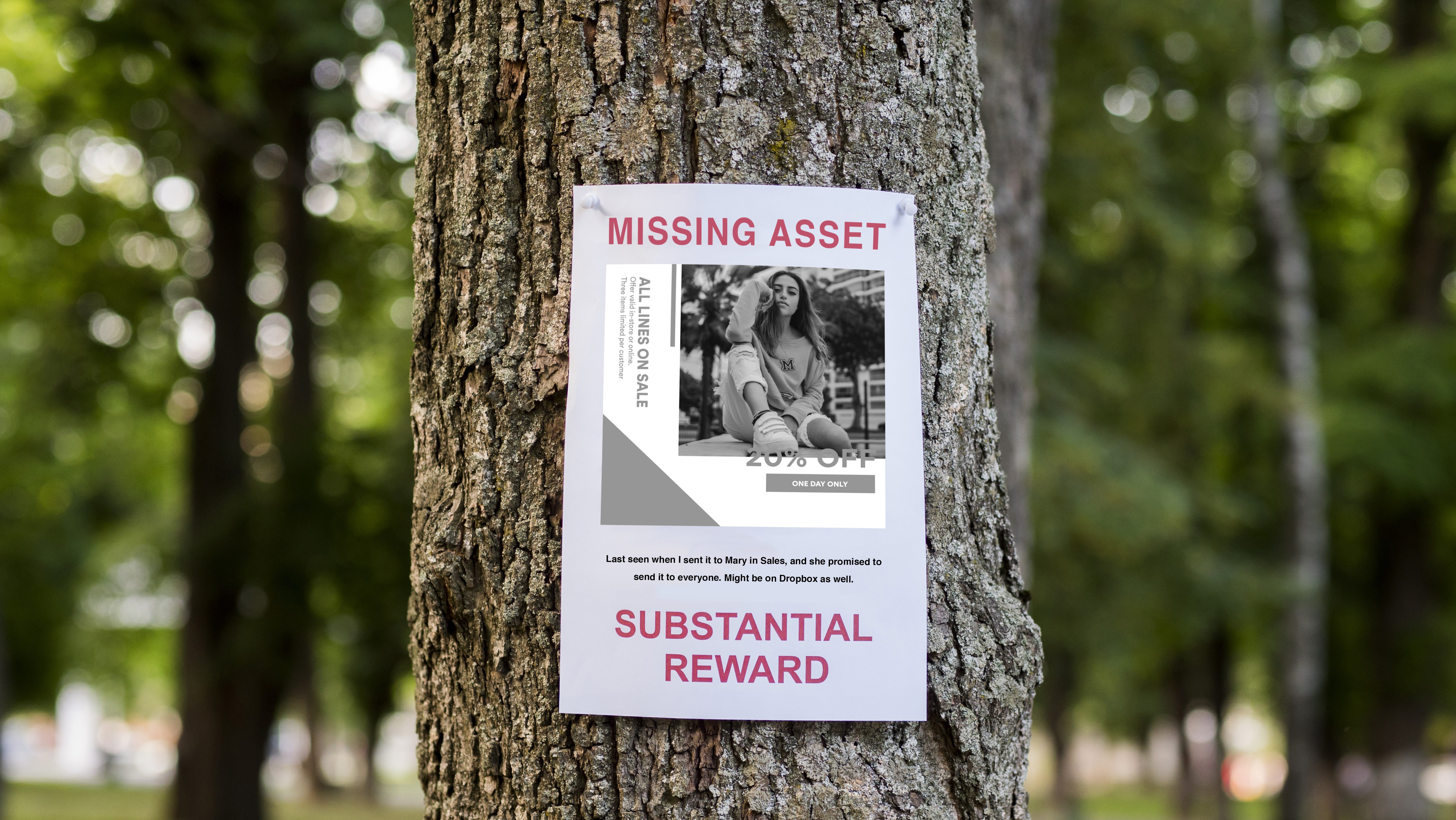How to Solve 7 Painfully Common Marketing Frustrations
Is there anything more frustrating than creating a marketing piece—only for no one to use it?
Or what about some of these painfully common marketing frustrations:
Lengthy approval email chains
Endless requests for files (from sales teams, clients, etc.)
Brand crime by people who have no business creating their own marketing collateral
Unnecessary rework
Asset chaos and messy shared drives
Stakeholders who have no idea what's available
Not knowing if your work is actually making a difference
Any of those sound familiar? Perhaps too familiar?
If your team struggles with any of the above frustrations, digital asset management (DAM) for marketers can be a tremendous help. Believe it or not, many marketing frustrations can be resolved simply by improving how you organize and distribute files.
Here's a detailed look at each frustration—and how a DAM can help your marketing team resolve each one.
1. Lengthy email approval chains

What it sounds like: "I hate having to keep track of these forever-long email chains. I can't tell who wrote what, and I keep losing track of the attachments."
To be sure, A DAM isn't going to reduce the number of people who review your projects.
It can, however, save your sanity when you get one of those crazy-long email chains that fly around during approvals.
The most difficult part of those approval chains is keeping track of the attachments, which often get lost when someone forwards or replies to the chain.
Instead of relying on email, a DAM can make it much easier to keep everyone on the same page.
You can do this by creating a location within your DAM that's only accessible to people in your approval chain. Instead of sending an email attachment with a review request, send a direct link to the file in the DAM.
That way everyone uses one file, and you don't have to keep track of 10 different versions from your inbox.
2. Endless requests for files (from sales teams, clients, etc.)

What it sounds like: "Hey, the Sales VP called again. Can you send her the latest version of the sales deck?"
Every received an email from someone in your organization asking for a file? Something like:
"Do we have an updated sales deck?"
"Can you send me the latest photos for our promotional products?"
"Have we ever sent a mailer to people in my sales territory?"
Usually, requests like these arrive on short notice:
"We're headed to the customer in the morning."
"Can you get it to us today? We want to print 6,000 of them before the weekend."
For many marketers, this is a regular part of the job.
Usually, these requests aren't difficult to deal with—maybe 10-15 minutes each to find what the person needs and send it back to them.
But those requests add up. Even a few a week can turn into hundreds of hours a year spent sending out files.
What if—instead of fulfilling those requests manually—you provided an easy-to-use database of all your latest marketing collateral?
A well-designed DAM does just that.
It is a library of all your approved, most up-to-date files. It can also organize your assets so stakeholders know exactly where to go to find what they need.
We're not saying you won't still receive requests from people for the latest version of a file.
But a DAM will help you receive fewer of them.
When you do receive a file request, instead of going digging, just point the person to the DAM library, where they can find what they need on their own.
3. Brand crime by people who have no business creating their own marketing collateral

What it sounds like: "They showed this during a customer presentation???"
One marketer told us about going on a sales call visit with a member of his sales team.
They went to present a proposal in hopes of landing a contract, and the salesperson was supposed to use the standard pitch deck marketing had spent months perfecting.
This salesperson did not use the standard sales deck, however. He created his own.
It was superhero-themed—full of clipart and other photos he'd pulled from Google image searches.
"It was hideous," the marketer told us. "I was embarrassed to be there."
We call this "brand crime"—when people outside of marketing create their own (often horrendously bad) marketing materials and use them with customers and prospects.
Brand inconsistency is also extremely common. When people produce their own content instead of using what marketing provides, they risk including inaccurate information about products and services to the customer.
These issues are often minor. But we've seen some doozies—not unlike the marketer in this story.
When you spend months perfecting a piece of collateral, the least your stakeholders can do is use it—correctly.
A DAM removes the "I didn't know we had that" or "I couldn't find it" excuses so common among sales teams, PR firms, and other stakeholders.
4. Unnecessary rework

What it sounds like: "Didn't we already do a photoshoot for this product? What happened to the files?"
Ever been forced to redo something because you couldn't find the files?
One marketing team we know supports an eCommerce website with thousands of products.
Commissioning photos of those products is a major part of the marketing team's job.
Before implementing a DAM, the team had repeatedly paid for half-day reshoots of a product line—because the files from the original shoot were misplaced.
"Sometimes they get lost as attachments in someone's email," the marketing director told us, "or they get loaded on a portable hard drive that somehow gets misplaced."
If you have to manage thousands of files the way this company does, a DAM gives the entire team one place to load and store files—and those files will stay organized easy-to-find for as long as you need them.
That alone will prevent much of the duplicate work.
5. Asset chaos and messy shared drives

What it sounds like: "Why are there seven different versions all marked 'final'? Which one am I supposed to use?"
The first computer folder appeared on the Xerox Star in 1981 and was later popularized by Mac and Windows operating systems.
Folders were meant to help us stay organized, but in many cases, they end up creating a huge digital labyrinth.
Our personal hard drives are bad enough, but shared drives are even worse.
There you have multiple people—each with their own naming and organization system.
The result is a confusing mess you have to navigate any time you want to find, save, or copy a file from your database.
A DAM can help you resolve this problem by switching from a folder-based system to a tag-based system.
Instead of spending minutes looking through a maze of folders, search for what you're looking for, and you'll find it based on its description and associated tags.
It's a bit like a search engine—which we're all used to now. It allows your team (and your stakeholders) to find digital assets much faster than you can with traditional folders.
6. Stakeholders who have no idea what's available

What it sounds like: "This has been available for over a year? Why didn't anyone tell me?"
One marketing VP we know spent years trying to get her company to stop using an old logo she fought hard to replace.
"I'd see the old logo in email signatures, on powerpoint decks, on stationary," she told us. "It drove me crazy."
The worst part is that—no matter how many times she put a message in the all-company email—she kept running into people who didn't even know the logo had changed.
Many marketing teams know the frustration of this problem.
You spend weeks or months on a piece of marketing collateral, you release it through all the official channels, but the people outside of marketing just don't seem to be paying attention.
A DAM creates a "single source of truth" for files and collateral throughout your company and partner organizations.
Stakeholders are often dependent on the marketing and creative teams to send them the most recent materials, and this doesn't always happen quickly after assets are created.
A DAM keeps everyone current—since there is no delay in receiving the most recent materials.
It will still take some training—people will need to learn to pull from the DAM instead of from their personal hard drives when they use an image or a file.
But a DAM does take away the excuse that "no one told us" or "I didn't know that was available."
7. Not knowing if your work is actually making a difference

What it sounds like: "Is anyone from the sales team using this?"
Do you know if anyone is using the materials you create?
Is your sales team using the presentation decks you created? Are your partners using the product images you provided to them? How many times has someone downloaded the white paper you published last year?
Most marketing teams are completely blind to the popularity of their work.
They rely on surveys or anecdotal evidence to know if anyone is using what they create.
That makes it very difficult to know if you should continue creating similar collateral—since you have no data to make a good decision.
When you have detailed information about usage and popularity, however, it can be a tremendous help.
A DAM includes built-in analytics that help you do exactly that: see what's being used and what's being ignored.
You'll be able to see how often someone has accessed each file in your system, along with how many times it has been viewed or downloaded.
If one of your pieces goes "viral" internally—and everyone has to have it because they love it so much—you'll see it.
Based on that usage data, you'll be able to commit resources to additional pieces like that one moving forward—instead of just guessing.
Digital Asset Management for Marketers
Ever spent 10 minutes trying to find your keys in the morning when you're trying to get out the door for work?
Digging around a messy file drive is the digital equivalent—but worse, since it happens much more frequently.
In marketing departments, this lack of organization is a waste of time, energy, and productivity for everyone involved, and it's also unnecessary.
Digital asset management for marketers is a straightforward, easy-to-implement approach to staying organized.
It's also one of the best ways to improve results and resolve many of the frustrations so common to marketing.
